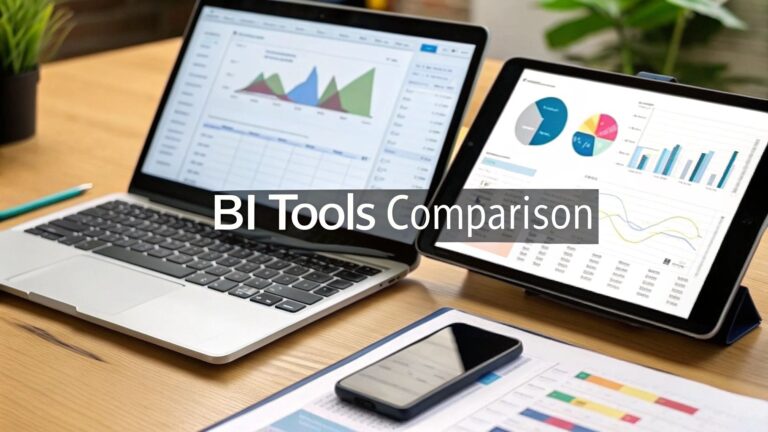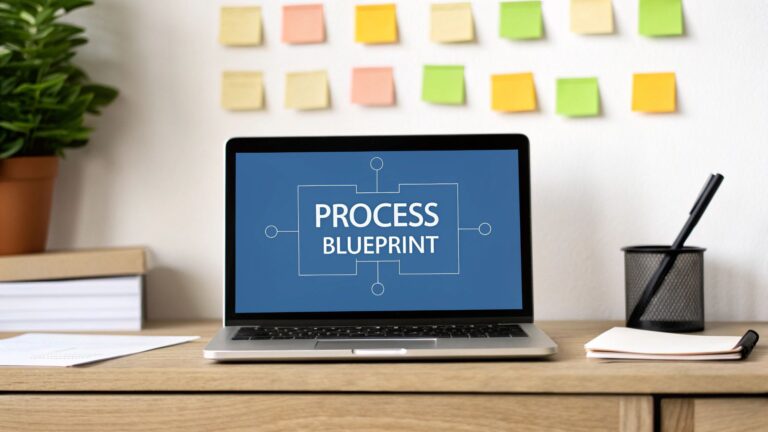sales operations best practices for peak performance
In the competitive landscape of B2B and SaaS, the difference between hitting targets and falling short often lies not in the product, but in the process. While top-tier salespeople are crucial, the invisible engine that powers their success is a finely tuned sales operations function. It's the framework that transforms chaotic, individual efforts into a predictable, scalable revenue machine. This is the strategic core that allows sales teams to sell smarter, not just harder.
This guide moves beyond generic advice to provide a comprehensive breakdown of actionable sales operations best practices. We will explore 10 specific, battle-tested strategies that drive efficiency, improve forecasting accuracy, and ultimately, accelerate sustainable growth. You will learn how to turn operational friction into a streamlined advantage.
We will cover critical areas from Customer Relationship Management (CRM) System Optimization and Sales Force Automation (SFA) to strategic initiatives like Sales Territory Management and Account-Based Selling (ABS). Each point is designed to provide practical implementation details, helping you build a more effective and data-driven sales organization. Prepare to learn precisely how to implement the processes that separate high-performing sales teams from the rest, turning your sales organization into a model of operational excellence. This isn't about theory; it's about building the infrastructure for repeatable success.
1. Sales Force Automation (SFA) Implementation
Sales Force Automation (SFA) is a foundational sales operations best practice that involves using technology to automate repetitive, time-consuming sales tasks. This includes data entry, contact management, email sequencing, and pipeline updates, freeing up sales representatives to focus on high-value activities like building relationships and closing deals. By centralizing customer data and sales activities, SFA systems provide a single source of truth, enhancing collaboration and strategic planning.

The core purpose of SFA is to streamline the entire sales process, from lead generation to post-sale follow-up. It provides real-time visibility into sales performance, enabling leaders to make data-driven decisions, accurately forecast revenue, and identify bottlenecks in the sales funnel. This level of insight is crucial for scaling a B2B or SaaS sales team effectively. For a deeper understanding, explore the fundamentals of sales automation.
Actionable Implementation Tips
Implementing an SFA platform like Salesforce, HubSpot, or Microsoft Dynamics requires a strategic approach rather than a simple software rollout.
- Start with Core Needs: Begin by implementing essential features like contact management, activity tracking, and opportunity management. Avoid overwhelming your team with advanced functionalities until the core system is fully adopted.
- Prioritize Comprehensive Training: Ensure every member of the sales team receives thorough, role-specific training. Ongoing education is key to maximizing adoption and unlocking the platform's full potential.
- Establish Data Governance Early: Create clear rules for data entry and maintenance from day one. Consistent, clean data is the backbone of reliable reporting and accurate forecasting.
- Set Clear SFA-Tied KPIs: Define and track key performance indicators (KPIs) that measure the SFA's impact. Examples include reduction in sales cycle length, increase in deals managed per rep, or improved lead conversion rates.
- Schedule Regular Audits: Conduct quarterly or semi-annual platform audits to identify unused features, address user issues, and optimize workflows for changing business needs.
2. Sales Territory Management and Alignment
Sales Territory Management and Alignment is a strategic sales operations best practice that involves dividing a market into defined segments, or territories, and assigning them to specific sales representatives or teams. These territories are typically defined by geography, industry vertical, or account size, ensuring equitable opportunity distribution and preventing internal competition over the same prospects. The goal is to maximize market coverage and revenue potential by aligning sales resources with the most promising opportunities.
Effective territory management ensures that sales reps have a balanced workload and a clear focus, which boosts morale and productivity. For B2B and SaaS companies, this means reps can develop deep expertise within their assigned segment, leading to more meaningful customer relationships and higher close rates. A well-designed plan provides a fair and transparent framework for performance evaluation and compensation, which is critical for retaining top talent. For more context on strategic planning, the Alexander Group offers deep insights into sales compensation and territory design.
Actionable Implementation Tips
Implementing a successful territory management plan goes beyond simply drawing lines on a map; it requires a data-driven and dynamic approach.
- Use Data to Inform Territory Design: Analyze historical sales data, market potential, and customer distribution to create territories. Avoid relying solely on geography; consider factors like industry concentration and potential account value.
- Balance Potential, Not Just Workload: Aim for territories with equal sales potential, not just an equal number of accounts or geographic area. This ensures every representative has a fair chance to meet their quota.
- Review and Adjust Territories Regularly: Markets change, so your territories must adapt. Conduct quarterly or semi-annual reviews to rebalance territories based on performance data, market shifts, and team changes.
- Communicate Changes Transparently: When adjustments are necessary, clearly communicate the rationale to the sales team. Transparency builds trust and helps reps understand how the changes support both individual and company goals.
- Factor in Career Development: Align territory assignments with the career paths of your sales reps. Assigning a high-potential territory to an experienced rep or a developing territory to a newer one can be a powerful tool for growth and motivation.
3. Sales Enablement and Content Management
Sales enablement is a strategic, cross-functional discipline designed to increase sales results and productivity by providing integrated content, training, and coaching services for salespeople. This best practice for sales operations involves equipping the sales team with the resources, tools, and information they need to engage buyers effectively at every stage of their journey. Centralizing assets like case studies, product sheets, competitive intelligence, and playbooks ensures consistency and accessibility.
The core purpose of a robust sales enablement program is to shorten the sales cycle and improve win rates by making reps more knowledgeable and efficient. Platforms like Highspot, Seismic, and Showpad act as a single source of truth, helping sales ops leaders manage content, deliver just-in-time training, and provide reps with the most relevant materials for any given sales scenario. This structured approach transforms sales from a reactive function to a proactive, well-oiled machine. For an in-depth look, you can explore more sales enablement best practices.
Actionable Implementation Tips
Building a successful sales enablement function goes beyond simply creating a content library; it requires a deep understanding of both sales processes and buyer needs.
- Conduct a Needs Assessment: Before launching any program, interview sales reps, managers, and marketing teams to identify the biggest gaps in content, skills, and tools. This ensures your enablement efforts are targeted and impactful.
- Involve Sales in Content Creation: The sales team is on the front lines and knows what resonates with prospects. Involve them in the content creation and feedback loop to ensure materials are practical, relevant, and used.
- Track Content Usage and Effectiveness: Use an enablement platform’s analytics to monitor which assets are being used most frequently and which ones are correlated with successful deals. This data is crucial for optimizing your content strategy.
- Integrate with Your CRM: Connect your enablement platform with your CRM (e.g., Salesforce). This allows reps to access relevant content directly from an opportunity record and provides sales ops with a clearer view of how content influences pipeline.
- Regularly Update Content: Use win/loss analysis and feedback from the sales team to continuously refine and update your content repository. Outdated or irrelevant materials can quickly undermine the credibility of your enablement program.
4. Sales Pipeline Management and Forecasting
Sales Pipeline Management is a core sales operations best practice that involves the systematic tracking, analysis, and management of sales opportunities as they move through defined stages, from initial contact to a closed deal. This discipline is paired with forecasting, which uses pipeline data to predict future revenue outcomes. Together, they provide a clear view of business health, identify potential bottlenecks, and allow leadership to allocate resources effectively.
Effective pipeline management and forecasting ensure that sales efforts are aligned with revenue goals, preventing end-of-quarter surprises. It transforms sales from a reactive function into a predictable, data-driven engine for growth. By maintaining pipeline hygiene and using historical data, organizations like those leveraging Salesforce Einstein or Gong for predictive analytics can achieve remarkable forecast accuracy and optimize their sales processes for maximum efficiency.
Actionable Implementation Tips
Building a robust pipeline management and forecasting process requires discipline and a commitment to data integrity.
- Establish Clear, Measurable Stage Criteria: Define exactly what must happen for a deal to move from one stage to the next. These exit criteria should be objective and verifiable, such as "Completed Product Demo" or "Received Verbal Commitment," eliminating ambiguity.
- Conduct Weekly Pipeline Reviews: Sales managers should hold consistent, one-on-one pipeline review meetings with each rep. These sessions should focus on strategy, identifying at-risk deals, and coaching on next steps, not just data entry updates.
- Use Historical Data for Probability Weighting: Instead of using generic percentages, analyze historical conversion rates from each stage to assign more accurate, data-backed probability weights. This greatly improves the reliability of your revenue forecast.
- Implement Automated Pipeline Health Checks: Use your CRM or sales analytics tools to create automated alerts for deals that are stalled, lack recent activity, or have a sales cycle that exceeds the average. This helps reps proactively address potential issues.
- Build in a Buffer for Contingency Planning: Even the most accurate forecast can be affected by unforeseen circumstances. A best practice is to build a conservative buffer into your final revenue projection to account for deals that might slip or be lost unexpectedly.
5. Sales Performance Analytics and Metrics
Sales Performance Analytics is a data-driven approach to measuring, analyzing, and optimizing sales team performance through Key Performance Indicators (KPIs) and advanced analytics. It moves beyond simple revenue tracking to provide deep insights into the entire sales funnel. This practice is central to effective sales operations best practices, as it allows leaders to diagnose issues, coach individuals, and make strategic decisions based on quantitative evidence rather than intuition.

The core purpose of this practice is to create a culture of continuous improvement fueled by data. By tracking metrics like conversion rates, sales cycle length, deal size, and win rates, organizations can identify trends and replicate successful behaviors across the team. A key aspect of sales operations is defining and tracking essential sales performance metrics to measure success and identify areas for improvement. This level of analysis is crucial for predicting revenue, allocating resources effectively, and scaling growth sustainably.
Actionable Implementation Tips
Implementing a robust analytics framework requires more than just access to a business intelligence tool like Tableau or Microsoft Power BI; it demands a strategic mindset.
- Focus on Leading Indicators: While lagging indicators like closed revenue are important, prioritize leading indicators such as discovery calls booked, demos completed, or proposals sent. These metrics provide an early warning system and allow for proactive coaching.
- Align Metrics with Business Goals: Ensure every KPI you track is directly tied to a broader company objective. If the goal is market expansion, track metrics related to new logo acquisition. If it's profitability, focus on deal margin.
- Avoid "Analysis Paralysis": Limit your primary dashboard to 5-10 core metrics that provide the most insight. Too many KPIs can overwhelm the team and dilute focus from what truly matters for performance.
- Establish a Review Cadence: Schedule regular, data-driven review sessions (weekly or bi-weekly) with sales reps to discuss their performance metrics. Use these meetings as coaching opportunities to identify strengths and address challenges.
- Combine Quantitative with Qualitative: Supplement the numbers with qualitative feedback from call recordings and one-on-one meetings. Tools like Gong or Revenue.io can help analyze conversations to understand why certain metrics are trending up or down.
6. Sales Compensation Plan Design
Sales Compensation Plan Design is a strategic framework for structuring how sales professionals are paid, including base salary, commissions, bonuses, and other incentives. This is a critical sales operations best practice because a well-designed plan does more than just pay people; it actively motivates desired behaviors, drives performance against key business objectives, and helps attract and retain top-tier talent. The goal is to align individual sales activities directly with overarching company goals, such as market share growth, new product adoption, or profitability.
A thoughtfully constructed compensation plan acts as a powerful communication tool, clearly signaling to the sales team what outcomes the company values most. By tying financial rewards to specific achievements, it creates a direct link between a representative's effort and their earnings potential, fostering a high-performance culture. This strategic alignment ensures that the sales force is not just busy, but is focused on the activities that generate the most value for the organization.
Actionable Implementation Tips
Designing a plan that is both motivating and sustainable requires careful consideration and a structured approach. It's about balancing simplicity, fairness, and strategic alignment.
- Align with Key Business Priorities: Ensure your compensation plan directly supports current strategic initiatives. For example, if launching a new product is a top priority, use commission accelerators or special bonuses for its sales.
- Keep it Simple and Clear: A plan that is too complex is difficult for reps to understand and for operations to administer. Salespeople should be able to quickly calculate their potential earnings from any given deal.
- Balance Incentive Components: Create a healthy mix of individual, team, and company-level incentives. This encourages both individual excellence and collaborative efforts that benefit the entire organization.
- Review and Adjust Annually: The market, your products, and your business goals will change. Conduct an annual review of your compensation plan, using market data from firms like Radford or Mercer, to ensure it remains competitive and relevant.
- Communicate Changes Transparently: When adjustments are necessary, communicate them clearly and well in advance. Explain the "why" behind the changes to secure buy-in and maintain trust with the sales team.
7. Sales Coaching and Development Programs
A commitment to continuous improvement is one of the most impactful sales operations best practices, and it is best achieved through structured sales coaching and development programs. This approach moves beyond sporadic training events to a consistent, data-driven system for enhancing rep capabilities. It involves regular one-on-one coaching, skill assessments, and personalized development plans designed to address specific performance gaps and build a high-performing, motivated team.
The goal of a formal coaching program is to create a culture of learning and excellence where reps feel supported in their professional growth. By leveraging call recording software like Gong and sales engagement data, managers can provide targeted, evidence-based feedback. This transforms coaching from subjective opinion into objective, behavior-focused guidance that directly impacts outcomes like quota attainment and deal size. To explore proven frameworks, consider resources like Coaching Salespeople into Sales Champions by Keith Rosen.
Actionable Implementation Tips
Building an effective coaching program requires more than just scheduling meetings; it demands a deliberate, structured process supported by sales operations.
- Train Your Managers to Coach: Equip sales managers with formal coaching techniques. Focus on teaching them how to ask powerful questions, facilitate self-discovery, and guide reps toward solutions rather than simply giving orders.
- Leverage Technology for Insights: Use call recording and conversation intelligence tools to identify coachable moments. Analyze metrics like talk-to-listen ratios, competitor mentions, and how top performers navigate objections to create targeted training content.
- Focus on Behaviors, Not Traits: Center coaching conversations on specific, observable behaviors (e.g., "You asked only two discovery questions on that call") instead of vague personality traits (e.g., "You need to be more curious"). This makes feedback actionable and less personal.
- Create Individual Development Plans (IDPs): Work with each rep to create a personalized IDP that outlines specific skills to develop, actions to take, and clear metrics for success. Revisit and update these plans quarterly.
- Establish a Consistent Coaching Cadence: Implement a regular schedule for coaching sessions, such as weekly call reviews and monthly performance check-ins. Consistency makes coaching a routine part of the sales culture, not an occasional intervention.
8. Account-Based Selling (ABS) and ABM Strategy
Account-Based Selling (ABS) and its marketing counterpart, Account-Based Marketing (ABM), represent a strategic shift from a broad, lead-centric funnel to a highly focused, account-centric approach. Instead of casting a wide net, this methodology treats individual high-value accounts as unique markets, coordinating personalized sales and marketing efforts to engage multiple stakeholders within those organizations. This alignment ensures that every touchpoint, from an initial ad to a final sales call, is consistent, relevant, and designed to address the specific needs of the target company.
This targeted strategy is one of the most effective sales operations best practices for B2B and SaaS companies pursuing enterprise clients. It moves beyond simple lead volume and focuses on landing and expanding key accounts that drive significant revenue. By concentrating resources on a select group of prospects, teams can build deeper relationships, shorten complex sales cycles, and significantly increase deal sizes. Platforms like Terminus and 6sense have popularized this data-driven approach to targeting and engaging high-fit accounts.
Actionable Implementation Tips
Implementing a successful ABS and ABM strategy requires deep collaboration between sales, marketing, and customer success, guided by robust operational support.
- Launch a Pilot Program: Start small by identifying your top 20-30 ideal customer profile (ICP) accounts. Use this pilot to test your messaging, refine your multi-channel outreach cadence, and prove the model's ROI before scaling.
- Develop Detailed Account Plans: For each target account, create a comprehensive plan that outlines key stakeholders, their specific pain points, business objectives, and a tailored engagement strategy. This plan becomes the playbook for both sales and marketing.
- Engage Multiple Stakeholders: Modern B2B buying decisions involve multiple influencers and decision-makers. Use tools like LinkedIn Sales Navigator to identify and engage the entire buying committee with personalized messaging relevant to their roles.
- Align Content with the Buyer's Journey: Create and map personalized content assets, such as case studies, ROI calculators, and industry reports, to each stage of the target account's decision-making process.
- Measure Account-Level Metrics: Shift your success metrics from lead-based KPIs to account-focused ones. Track metrics like account engagement, pipeline velocity within target accounts, deal size, and ultimately, customer lifetime value.
9. Sales Process Standardization and Documentation
Sales Process Standardization is a critical sales operations best practice that involves creating and documenting a consistent, repeatable methodology for the entire sales organization. This framework defines every stage of the sales cycle, the specific activities reps must complete, and the criteria required to advance a deal. By establishing a unified approach, companies can ensure predictability, reduce performance variability, and create a scalable engine for revenue growth.

The core purpose of a standardized process is to move away from reliance on individual "hero" reps and toward a system where success can be replicated across the entire team. It provides a clear roadmap for new hires, accelerates ramp-up time, and makes coaching more effective because managers can pinpoint exactly where a rep is deviating from the proven playbook. Methodologies like SPIN Selling, popularized by Neil Rackham, or the Sandler Sales System provide foundational frameworks that many organizations adapt to their specific needs.
Actionable Implementation Tips
Building a standardized process that sticks requires collaboration and a focus on what already works within your team, rather than imposing a rigid, top-down mandate.
- Model After Top Performers: Analyze the habits, activities, and strategies of your most successful sales reps. Build the standardized process around these proven best practices to ensure it is practical and effective.
- Involve the Sales Team: Co-create the process with input from the entire sales team. This bottom-up approach fosters a sense of ownership and significantly increases the likelihood of adoption.
- Document with Visual Aids: Create clear, accessible documentation that includes visual flowcharts, checklists, and battle cards for each stage. Store this playbook in a central, easy-to-find location.
- Train and Certify: Conduct formal training sessions on the new standardized process for all team members, both new and veteran. Consider a certification process to ensure comprehension and adherence.
- Measure and Refine Quarterly: The sales process should be a living document. Schedule quarterly reviews to analyze performance data, gather feedback from the team, and refine the process to adapt to changing market conditions or internal goals.
10. Customer Relationship Management (CRM) System Optimization
Customer Relationship Management (CRM) system optimization is a critical sales operations best practice that transforms a CRM from a simple digital rolodex into a strategic revenue-driving engine. This practice involves the continuous refinement of a CRM platform like Salesforce or HubSpot to manage all customer data, interactions, and relationships effectively. A well-optimized CRM provides a 360-degree view of the customer, empowering sales teams with the insights needed for personalized engagement and efficient pipeline management.
The primary goal of CRM optimization is to ensure the platform actively supports and enhances the sales process, rather than just passively storing information. This involves automating workflows, integrating with other business-critical tools, and customizing dashboards to deliver actionable intelligence. For businesses looking to optimize their CRM systems, exploring specific platforms like Dynamics 365 Sales CRM can provide valuable insights into advanced capabilities. A properly tuned CRM enables sales leaders to accurately forecast revenue, identify sales cycle trends, and coach reps based on real performance data. For more on connecting your tools, discover the benefits of CRM integration.
Actionable Implementation Tips
Optimizing a CRM is an ongoing initiative that requires strategic planning and consistent attention to user needs and business goals.
- Conduct Regular Audits: Perform quarterly CRM health checks to identify and clean up bad data, remove unused fields or reports, and assess user adoption rates. Use this time to gather feedback on process bottlenecks.
- Implement Strong Data Governance: Establish and enforce clear, simple rules for data entry, including required fields for lead conversion and opportunity creation. This ensures data consistency and reporting accuracy.
- Focus on User-Centric Dashboards: Customize dashboards for different roles (e.g., Sales Rep, Sales Manager, Executive). A rep’s dashboard should focus on their pipeline and daily activities, while a manager's should highlight team performance and forecasting.
- Prioritize High-Impact Automations: Start by automating simple, repetitive tasks that save the most time, such as follow-up reminders, lead assignment rules, or data enrichment for new contacts.
- Tie Adoption to Performance: Make CRM usage a key component of sales performance reviews. Track metrics like login frequency, record updates, and activity logging to encourage consistent adoption and accountability.
Sales Ops Best Practices: 10-Point Comparison
| Item | Implementation complexity | Resource requirements | Expected outcomes | Ideal use cases | Key advantages |
|---|---|---|---|---|---|
| Sales Force Automation (SFA) Implementation | High — integrations and change management | Significant: platform licenses, IT, training | Reduced admin, faster cycles, improved forecast visibility | Teams needing task automation and pipeline visibility | Automates repetitive work; improves productivity and reporting |
| Sales Territory Management and Alignment | Moderate–High — requires analysis and periodic realignment | Data analysis, planning resources, regular reviews | Balanced workloads, improved coverage, better forecasting | Field sales, geo- or account-based coverage models | Reduces account conflict; increases quota attainment and coverage |
| Sales Enablement and Content Management | Moderate — tool setup and content workflows | Content creators, enablement tools, training | Faster ramp, consistent messaging, higher win rates | Scaling sales orgs or complex product portfolios | Centralized resources; boosts rep effectiveness and consistency |
| Sales Pipeline Management and Forecasting | Moderate — process definition and CRM discipline | CRM use, analytics, manager time for reviews | Improved forecast accuracy; earlier bottleneck detection | Organizations seeking predictable revenue and better forecasting | Data-driven forecasts; proactive deal management and prioritization |
| Sales Performance Analytics and Metrics | Moderate — analytics setup and governance | BI tools, clean data, analysts or ops support | Actionable insights, targeted coaching, performance improvement | Data-driven sales ops and performance management | Reveals trends and gaps; supports objective coaching and decisions |
| Sales Compensation Plan Design | High — complex modeling and fairness concerns | Compensation analysts, HR/legal input, admin systems | Aligned incentives, improved retention and motivation | Companies aligning behavior to strategic objectives | Drives desired behaviors; attracts and retains top performers |
| Sales Coaching and Development Programs | Moderate — program design and manager enablement | Manager time, training materials, coaching tools | Improved rep performance, reduced turnover, leadership growth | Teams investing in long-term talent development | Boosts skills and engagement; accelerates rep improvement |
| Account-Based Selling (ABS) and ABM Strategy | High — cross-functional coordination required | Research, marketing resources, dedicated account teams | Higher win rates, larger deal sizes, stronger relationships | Targeting high-value enterprise accounts and strategic buyers | Personalized multi-stakeholder engagement; higher ROI per account |
| Sales Process Standardization and Documentation | Moderate — design, documentation and adoption effort | Time to document, training, governance and audits | Consistent outcomes, faster onboarding, scalable operations | Organizations needing repeatability and predictable sales motion | Predictability and repeatability; foundation for coaching and scaling |
| Customer Relationship Management (CRM) System Optimization | High — customization, integration and governance | Platform costs, IT resources, training, ongoing maintenance | Single source of truth, better engagement, data-driven insights | Firms centralizing customer data and automating workflows | 360° customer view; automation, integrations and scalable data insights |
From Strategy to Execution: Activating Your Sales Ops Excellence
The journey through the intricate world of sales operations reveals a fundamental truth: operational excellence is not a destination, but a continuous cycle of refinement and adaptation. The ten sales operations best practices we have explored, from implementing robust Sales Force Automation to optimizing your CRM, are not isolated tactics. Instead, they are interconnected pillars that form the foundation of a resilient, high-performance revenue engine. Mastering them means moving your organization from reactive problem-solving to proactive, strategic growth.
By embracing these principles, you are building more than just an efficient sales team; you are constructing a predictable system for success. You empower your reps with the tools, content, and processes they need to thrive, freeing them from administrative burdens to focus on what truly matters: forging strong customer relationships and driving revenue. The transition from chaotic, ad-hoc processes to a standardized, data-driven framework is transformative, turning your sales function into a well-oiled machine that can scale effectively and navigate market shifts with confidence.
Synthesizing the Pillars of Sales Ops Mastery
Let's distill the core themes that unite these best practices. The overarching goal is to create an environment where sales success is systematic, not sporadic. This is achieved through three key areas of focus:
- Systemization and Automation: Practices like SFA implementation, CRM optimization, and sales process standardization are about creating a single source of truth and automating repetitive tasks. This builds a reliable operational backbone, ensuring consistency and efficiency across the entire team.
- Data-Driven Decision Making: From pipeline forecasting and performance analytics to territory alignment, the modern Sales Ops leader relies on data, not intuition. Establishing clear metrics and leveraging analytics allows you to accurately diagnose problems, identify opportunities, and forecast future performance with greater confidence.
- Human Enablement and Empowerment: Ultimately, operations serve people. Effective sales enablement, strategic compensation design, and targeted coaching programs are crucial. These practices ensure your team is skilled, motivated, and equipped with the resources needed to execute the sales strategy flawlessly.
Your Actionable Roadmap to Implementation
The sheer scope of these ten practices can feel overwhelming. The key is to avoid trying to boil the ocean. Instead, adopt a phased, iterative approach to implementation. Begin by diagnosing your most significant operational bottleneck. Is your team drowning in manual data entry? Start with CRM optimization and automation. Are your sales cycles unpredictable and forecasts consistently off-target? Focus on pipeline management and process standardization first.
Here is a simple, actionable plan to get started:
- Conduct an Audit: Assess your current sales operations against the ten best practices discussed. Identify the one or two areas with the most significant gaps or the highest potential for immediate impact.
- Define a Pilot Project: Select a small, manageable project to tackle first. For example, document one core sales process or build a single performance dashboard.
- Measure and Iterate: Define success metrics for your pilot project before you begin. Once complete, measure the results, gather feedback from the sales team, and use those learnings to refine your approach for the next initiative.
By building momentum with small, tangible wins, you can foster buy-in from leadership and the sales team, creating a culture of continuous improvement. The power of superior sales operations lies in its compounding effect. Each enhancement, no matter how small, contributes to a more efficient, predictable, and powerful revenue-generating force that becomes a true competitive advantage.
Ready to transform your sales operations from a cost center into a strategic growth driver? MakeAutomation specializes in implementing the very systems and processes discussed in this guide. We help B2B and SaaS companies build scalable, automated revenue engines, so your team can focus on closing deals, not on manual tasks. Discover how MakeAutomation can architect your operational excellence.







